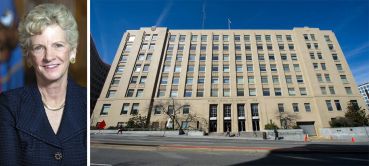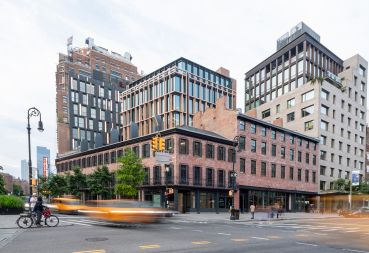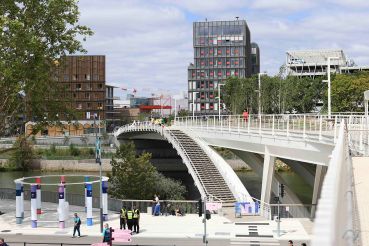Ten Years of New York City’s Construction Boom
By Rebecca Baird-Remba December 17, 2019 11:00 am
reprints
The last decade has been a banner one for New York City construction. The five boroughs have rebounded from the recession and two major hurricanes to reach 25-year highs in construction spending, according to the New York Building Congress.
In terms of residential construction, the city had nowhere to go but up when the 2010s began. The New York City Department of Buildings issued new building permits for just 6,727 residential units in 2010 — an extreme low for a metropolis that had approved nearly 34,000 apartments for construction in 2008, just before the recession struck. Residential development peaked in 2015 with permits for 56,183 homes and declined to 20,910 units in 2018.
“I think the numbers are very clear: It’s been a phenomenal time for construction,” said NYBC President Carlo Scissura. “It’s been a period of job growth and new construction on all levels — hospitals, institutional, government.” He noted that construction spending has “really doubled” over the past decade, from roughly $30 billion in 2010 to $56 billion in 2018.
The development boom of the last decade has given birth to a form of construction that New York City helped pioneer — supertall residential buildings. Manhattan’s 57th Street became known as Billionaire’s Row as it sprouted condominium towers reaching above 1,000 feet, beginning with Extell Development’s One57, followed by Harry Macklowe’s 432 Park Avenue (which was famously inspired by a trash can), Extell’s Central Park Tower and JDS Development’s 111 West 57th Street. There’s also 53 West 53rd Street, a 1,050-foot-tall condo building that hosts an expansion for the adjacent Museum of Modern Art, and 220 Central Park South, the almost-supertall high-rise designed by Robert A. M. Stern.
But most of New York’s residential development has not come wrapped in shiny skyscrapers that extend a mile above the street. Plenty of new construction arrived in the wake of rezonings passed by the administration of Mayor Michael Bloomberg. In the early 2000s, the city rezoned Downtown Brooklyn, Park Slope and Greenpoint and Williamsburg, which has helped spur the construction of thousands of new units in Brooklyn over the past decade. Similarly, the 2001 and 2008 rezonings of Long Island City have completely transformed what was once an industrial neighborhood into a forest of residential high-rises and hotels. The western Queens neighborhood has seen 16.3 million square feet of residential development (including 19,303 apartments), since 2006, according to data from the Long Island City Partnership.
Amid all these ambitious plans, the Department of Buildings stumbled along the way. In 2015, the Manhattan District Attorney’s office indicted some 50 people (including 11 building inspectors) for bribery schemes. And the city saw an alarming number of high-profile accidents and fatalities. Just last month, six people were charged by the Brooklyn District Attorney with criminal negligence in the 2018 death of construction worker Luis Sanchez Almonte, and in January the federal government once again ranked construction as the most fatal industry in New York City.
Still, the city government did everything it could to grease the wheels of development. There were 153,933 construction permits issued in 2018. And in the seven years since Bloomberg left office, his successor Mayor Bill de Blasio has rezoned a series of largely low-income areas throughout the five boroughs, including East Harlem, Inwood, Far Rockaway, Queens, Jerome Avenue in the Bronx, and East New York in Brooklyn.
While the results of the rezonings so far have been limited to large subsidized-housing developments and a smattering of market-rate projects in East Harlem, two of the mega-projects planned under Bloomberg have grown into full-fledged neighborhoods over the past couple years. In Brooklyn, the much-maligned Atlantic Yards (now called Pacific Park) has risen on top of an MTA railyard and a series of properties that were seized through eminent domain. Four residential buildings with roughly 1,200 apartments have opened so far, and another 11 buildings are in the works. When it’s complete, the 22-acre development is expected to include 6,430 apartments, including 2,250 affordable units.
Developers also rushed to get shovels in the ground before the 421a tax break expired in 2016. The Durst Organization famously suspended construction on its Halletts Point project in Astoria until the Real Estate Board of New York and the building trades struck a deal to revive the tax abatement program in early 2017. The new version incentivizes developers to use union labor on larger developments in exchange for a longer tax break, and it requires builders of most projects to set aside at least a quarter of their units as affordable in order to qualify.
Douglas Durst, who heads the Durst Organization, felt that architectural design had become much more important for new residential buildings over the past decade.
“Residential towers used to be put up and it didn’t matter,” said Durst. “They were were all white brick for themost part, and now they all have an element of aesthetic design for them.”
He pointed to VIA 57, his company’s tetrahedron-shaped, Bjarke Ingels-designed luxury rental tower on the Far West Side, as an example of how important design had become.
And 20 blocks south, an even higher profile project has risen atop the West Side Yard, where the Long Island Railroad, New Jersey Transit and Amtrak have all stored trains for the past century: In the wake of the recession, Related Companies and Oxford Properties constructed an elaborate platform over the eastern half of the yard, relying on a mix of both conventional and unconventional financing, like the controversial EB-5 program.
Hudson Yards is notable not only for being one of the largest real estate projects in New York City but for creating an entirely new office market west of Pennsylvania Station. The first building to open, the 52-story 10 Hudson Yards, was initially a struggle to lease. The 1.8-million-square-foot office tower opened in 2016 with high-profile tenants like L’Oreal, Coach and SAP, which helped attract a number of major tenants to Hudson Yards in the intervening years. And this year alone, 30 and 55 Hudson Yards opened their doors to companies like CNN, KKR, Warner Media, HBO, Millbank, Third Point, and Cooley, with four million square feet of new office space. Then, in the biggest lease of the year, Facebook signed in November for 1.5 million square feet of space across 30, 50 and 55 Hudson Yards. The deal includes 1.2 million square feet slated for the under-construction 50 Hudson Yards. BlackRock is also anchoring the building, which is set to open in 2022.
In March, Related and Oxford opened the public space and the mall, known as the Shops at Hudson Yards, at the 26-acre development. Besides the 720,000-square-foot retail building, the developers also opened The Shed, a $475 million performing and visual arts center. The residential portion of Hudson Yards includes the Diller Scofidio + Renfro-designed 15 Hudson Yards, which is a mix of condominiums and affordable rentals, and 35 Hudson Yards, which holds 143 condos and a 212-room Equinox-branded hotel.
“The last decade has been very significant in New York on the commercial side, because we went through a very long period of very little development in New York,” said Dean Shapiro, who helped oversee the construction of Hudson Yards as the head of U.S. development at Oxford Properties. “New York had very little new product on the market and it caused us to lag behind other major global cities.”
While Hudson Yards certainly seemed like a gamble at first, Shapiro explained that they quickly realized that many companies in Manhattan were hungry for new office space.
“There had been dramatic changes in the nature of the workforce and the nature of the workplace,” Shapiro noted. “And older, more conventional buildings were not catering to that as much as [employers] would like. People started waking up to the fact that real estate was strategic and could create a decisive advantage in the war for talent.”
He felt that the success of the Far West Side could be partially attributed to the development of new parks — like the High Line and the Hudson River Greenway — which “made that part of town much more livable.”
Shapiro also touted Oxford’s planned $2 billion redevelopment of St John’s Terminal in Hudson Square, which will be anchored by Google.
“That area is really on fire now,” he noted. “People are really looking for areas to the south and west that can attract a younger generation of worker.”
In terms of office development, the last decade has also seen the rebirth of the World Trade Center, which was master-planned by Skidmore, Owings & Merrill. Silverstein Properties, which leased the massive site in the Financial District just months before the September 11 attacks, has slowly rebuilt the office complex over the past 13 years. Silverstein finished the first piece of the new World Trade Center, 7 World Trade, in 2006, long before the rest of the complex came together. Construction began on One World Trade Center in 2006, but it didn’t really get going until the Port Authority brought on the Durst Organization in 2010 to develop and manage the building. The 1,776-foot-tall, 94-story skyscraper opened its doors in 2014 with anchor tenant Condé Nast occupying 24 floors. One World Trade has since been joined by 4 and 3 World Trade Center, which opened in 2013 and 2018 respectively.
Although Shapiro felt that Hudson Yards had been a more successful office project than the World Trade Center, Silverstein leasing director Jeremy Moss suggested the two developments weren’t competing at all.
“I don’t think we’re competing because I don’t think there’s enough new [office] construction,” said Moss. “We’ve both had ample [numbers of] tenants. Those that are interested in a transit oriented location would choose the World Trade Center. We’ve benefited from a lot of companies from diverse industries — Spotify, Uber, Zola, Asana. These are all household names in tech. Their value was to be right on top of a transportation hub.”
The 2010s have also seen some dramatic shifts in the construction industry. At the dawn of the 2000s, the unionized trades still reigned supreme in New York City’s construction labor force. But by 2008, the trades began to lose market share — particularly in residential construction — to their cheaper, non-unionized counterparts. When the recession effectively brought development and construction lending to a halt, construction unions were faced with a new reality of high unemployment and extreme cost-cutting.
In response, some of the construction trade unions have made an effort to lower their labor costs in order to remain competitive.
“Many of the unions — not all — have made significant changes to lower costs,” said Lou Coletti, head of contractor group Building Trades Employers Association. “Construction costs have come down, but we still have not had much success in terms of lowering insurance costs. Labor costs to some degree have declined but those costs have been offset by increases in the cost of materials and supplies and an increase in regulations.”
Coletti added that unions have attempted to reduce costs for developers by “reducing nonproductive work rules” that mandated multiple workers for one task, and by creating new job categories with lower pay and cheaper fringe benefits, which include health insurance.
The unions also now employ significantly more minority workers than they did 10 or 15 years ago, largely thanks to training and apprenticeship programs developed by Coletti and others. In 2015, black, Latino and other minority workers made up 55 percent of union construction employees, according to data collected by the Economic Policy Institute. On the non-union side of the construction industry, minority workers comprised 75 percent of those employed on job sites.
Lindsay Brake, a construction consultant at Gardiner & Theobald who oversees costs and budgeting on development sites, said that when she first came to the city in 2012, “no one spoke about non-union labor. It was a dirty word. I think the outlook was that there wasn’t the skilled labor force in non-union construction.” Now, she said that many companies have union and non-union (or open shop) construction arms, because there is so much work for contractors in the five boroughs.
And full employment in the construction industry has led to a skilled labor shortage, both in management and on-site labor.
“We really need more people going into the construction industry,” said Brake. “And certainly, in my field, we have a lot of projects coming into the office and we need to train more professionals.”
She also pointed out that there are now significantly more women employed in project management and contracting firms than there were even a decade ago.
“Before, you’d find women in construction in the architectural side or the furniture side,” she said. “In our company, when I first joined there were probably three [women] out of 100. Now we’re close to 40 percent. I think it helps that companies are introducing flexible hours and remote access [for women with families].”
Brake acknowledged, however, that the industry is still male-dominated, and that there are some older men on job sites who speak without realizing women are present.
“The other day I was on site and someone said something [inappropriate], and they realized there was a woman standing next to them. There will still be certain elements where they think they’re still surrounded by men, but that’s certainly changed.”


